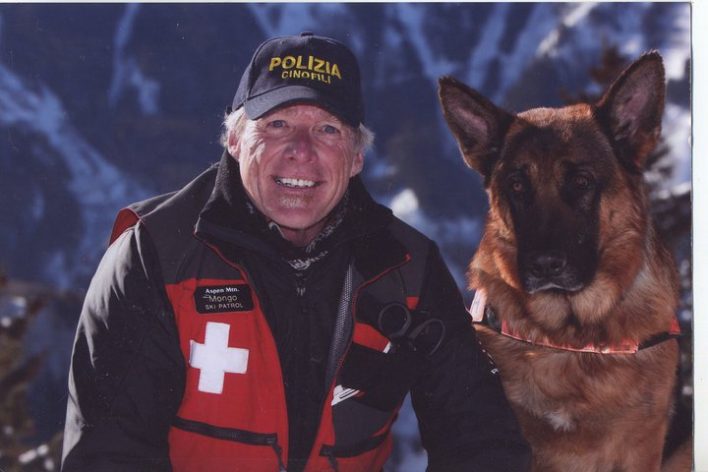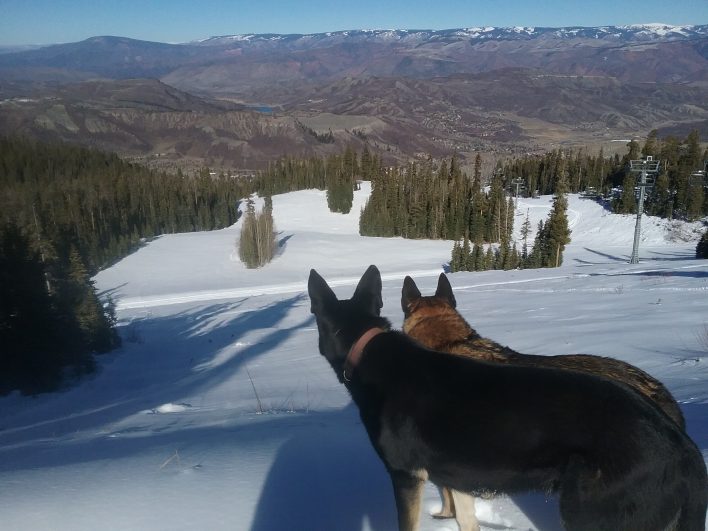Several years ago, a friend of mine was skiing with a group in the backcountry outside Telluride, Colorado. The group triggered an avalanche that caught several of its members. None of the skiers were killed, but my friend’s dog was buried and perished. Since that event, I have been developing a canine avalanche beacon, an endeavor that has opened my eyes to the disparate opinions about dogs in the backcountry.

Recently, I was having dinner with a woman in Ridgeway, Colorado. I told her about the beacon I had been working on, which would use a VHF frequency, differentiating it from the ones humans carry. This was important, I thought, because numerous people had objected to the idea that a dog might be found before a skier if its beacon used the current frequency.
My dinner companion responded, “Do not build it! Dogs do not belong in the backcountry!” I had not expected her response or vehement opposition to what I thought was a great idea. She explained that she was in the group near Telluride, and the dog had triggered the avalanche.
“Dogs do not belong in the backcountry,” she repeated. In 25 years of training and handling avalanche dogs, I had never encountered this opinion. When I was a patroller, my animals came with me everywhere, even on avy routes. My philosophy has been that they need to understand the process, environment and cardinal rules of travel in avalanche terrain. They also need to develop the skills to travel under their own power.
In the face of a dissenting opinion, I wondered, “Am I only surrounded by dog people? Do I never hear the other side of the debate?”
That thought set me on a new task: I needed to query dog people and non-dog people who skied in the backcountry, presenting them with a question, “Do dogs belong in the backcountry?” The answers surprised me.
I started by explaining the circumstances that gave rise to the question. Everyone I spoke with knew the woman whose dog was buried but not the background.
First, I reached out to two members of a renowned group of high-altitude mountaineers and skiers. These guys have been friends since high school. One almost always skis with his dog. The other does not. Each said the other would probably disagree with him, and it was easy to see that even with all their time stuck in a tent together that they had never talked about this.
The dog owner said, “Yes, absolutely, dogs belong in the backcountry. What she said is like saying wolves don’t belong in the wild,” referring to my dinner companion’s opinion. The issue was not the dog, he said, but the route selection: If the snowpack was that unstable, no one belonged there. All the dog people provided some version of this response about avalanche conditions.
His partner’s opinion was that dogs do not belong in the backcountry. “You control only the things you can control, especially in the BC. And no dog is totally controllable. They add risk to any situation, which is especially important to consider when the name of the game is reducing risk in situations encountered in the bc.” He pointed to a case when a dog went off a cornice and the recovery put people at risk.

Next, I reached out to a noted avalanche forecaster, ski patroller, dog handler and educator. His opinion was also somewhat unexpected. First, he said he was concerned about the physical effects of downhill running on the animals. Patrollers commonly worry about this regarding avy dogs at ski resorts.
Next, he pointed to another avalanche that killed a skier and dog. He suspected the pup’s random descent triggered the avalanche. The skier was killed by trauma.
His final points were also unexpected. As a search and rescue member, he said, searching for dogs was not his job. He was concerned people might be distracted or even use the simpler dog beacon instead of the new, more expensive digital UHF beacons, and he mentioned seeing uncontrolled, poorly managed dogs in the backcountry.
He admitted that he skis with his dog but didn’t think others should. So, I put this in the category of dogs are like farts—I dislike everyone’s but my own.
Now I reached out to a renowned ski mountaineer. This guy has a big presence in the backcountry ski scene, but in all the photos I never saw a canine companion.
His response was, “I grew up with dogs in our family. And I understand the dog lovers out there really enjoy having them along. It’s my opinion that a dog only adds to the risk and liability in the day and doesn’t contribute anything positive to a group outing.” I feel I need to mention that this fellow is a nice guy, but binary on this issue.
Finally, I’d like to add my opinion. Let me first say I’m old school. That means no dogs on the furniture and definitely not in the bed. My dogs are never allowed to disobey a command. If they do, we stop and reinforce what the appropriate response should be for 5 minutes. They speak three languages—voice, hand signals and hand claps. By combining the three, I keep the animal focused on me. We also practice the behaviors almost daily on the ski areas after the closing bell.
We do ski in the backcountry, but we have certain rules. First, never slopes that are steeper than 25 degrees. We ski in short segments, always gathering to restart and receive new directions. We limit our descent distances and make sure we are all in physical shape to handle the task.
I also carry a small first aid kit. Ski edges regularly cut dogs, so much that on Aspen Mountain I kept a surgical staple gun in the sick room for just such an emergency. I also carry a commercial rescue sling with backpack shoulder straps for an injured animal.
So, as they say, with great freedom comes great responsibility. Whether you ski with your dog or not is a personal decision. But if you do, be sure it’s an informed decision and you don’t endanger others. And I would caution to never get in a discussion with someone about religion, guns or their dogs.
Michael Ferrara lives in Colorado’s Roaring Fork Valley, where he was a ski patroller for 35 years. He has trained avalanche search dogs and been a member of Mountain Rescue Aspen for more than 20 years.










As a longtime dog person and one who has skied the Jackson Hole backcountry with his dogs for thirty years, as well as being the author of three books on dogs (Merle’s Door: Lessons From A Freethinking Dog, Pukka: The Pup After Merle, and Pukka’s Promise: The Quest for Longer-Lived Dogs), I’m with Ferrara: dogs should be allowed in the backcountry. I wholeheartedly agree with him that they need to be fluent in voice and hand commands and obey them, and that their people need to take exquisite care that they and their dogs aren’t endangering other skiers. At trailheads and on well-used trails, people also need to clean up after their dogs. That said, I would much rather go skiing with an obedient, experienced dog than some of the careless human skiers that now inhabit the backcountry, skiing unsafe lines when the avi danger doesn’t warrant venturing onto such slopes and imperiling the lives of those traveling beneath them. Ted Kerasote, Kelly, Wyoming
thank you Ted for your frank explanation. I agree. I’ve had 4 dogs in my adult life. Some are better at comprehending and behavior at a young age than others.knowing your dog is key. No dog should be out there until you have that connection. otherwise they are a liability.
Never ski alone, but a good dog is better than a bad person.